Etna-class replenishment oiler
The Etna class[2] is a ship class of two naval replenishment and logistic support ships used by the Italian Navy[3] and by the Greek Navy[4] The two ships are almost identical but they have differences in their armament and sensor equipment.
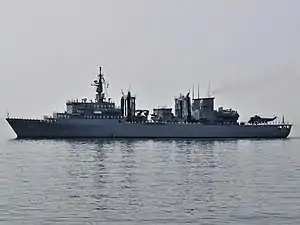 Etna (A 5326), Napoli 2010 | |
| Class overview | |
|---|---|
| Name | Etna |
| Builders | Italcantieri - Cantieri Navali del Tirreno e Riuniti, Riva Trigoso, Elefsis Shipyards |
| Operators | |
| In commission | 1998-2003 |
| Completed | 2 |
| Active | 2 |
| General characteristics | |
| Type | replenishment oiler |
| Displacement | |
| Length | |
| Beam | 21 m (69 ft) |
| Draft | 7.25 m (23.8 ft) |
| Depth | 7.4 m (24 ft) |
| Propulsion |
|
| Speed | 21 knots (39 km/h; 24 mph) |
| Range | 7,600 nmi (14,100 km; 8,700 mi) at 18 knots (33 km/h; 21 mph) |
| Complement | up to 245 |
| Crew | 160 |
| Sensors and processing systems |
|
| Electronic warfare & decoys |
|
| Armament |
|
| Aviation facilities |
|
| Notes |
|
Etna
Fincantieri shipyards were awarded the contract for Etna in July 1995, and the ship was launched in July 1997. The ship was commissioned into the Italian Navy in February 1998.
Etna's main role is to fully support the long-range missions of a naval squadron, which would typically include an aircraft carrier and complete escort. Additionally it has to be in position to refuel the squadron, including the air wing of the carrier, and also provide full logistic support in terms of repair workshops, spare parts, ammunition replenishment and supplies. The ship can play a crucial role in civil protection operations when asked. The ship has high autonomous capacity to provide electrical power, fresh water and prepared meals and also has fully equipped hospital and medical facilities on board.
HS Prometheus
The construction of the Greek ship HS Prometheus[5] began in Elefsina on February 18, 2000, at the Elefsis Shipyards. It was launched on February 19, 2002, and commissioned into the Greek Navy on July 8, 2003. It is the largest ship of the Hellenic Navy (in terms of displacement). The Greek Navy does not have an aircraft carrier like the Italian Navy so the primary role of the ship is different. As the largest ship of the fleet it is used as a Command ship.
General characteristics
Transport Capacity:
- 5.795 t (5.703 long tons) NATO F76 diesel fuel
- 1.585 t (1.560 long tons) NATO F44/JP5 aviation fuel
- 30 t (30 long tons) Lubrication oil
- 160 t (160 long tons) fresh water
Other facilities:
- 30,000 rations of food supplies
- up to 12 ISO1C containers, 28 t (28 long tons) each
- 20 t (20 long tons) spare parts
- NATO Role 2+ Hospital facilities
- NBC protection
- 1 workshop for helicopter operations aboard helicopter
- 1 machine shop for repairs on the hull and equipment on engines
- 1 electro-mechanical workshop
Cargo transfer system:
- 1 frame with 2 lateral liquid transfer stations
- 1 fuel transfer station astern.
Ships
| Ship | Navy | Namesake | Builder | Commissioned | Status |
|---|---|---|---|---|---|
| Etna (A 5326) | Etna | Fincantieri | July 29, 1998 | In Service | |
| HS Prometheus Προμηθέας | Prometheus | Elefsis Shipyards | July 8, 2003 | In Service | |
Gallery
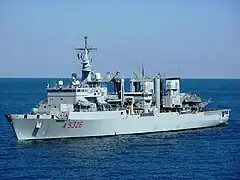 A 5326 Etna (2011)
A 5326 Etna (2011)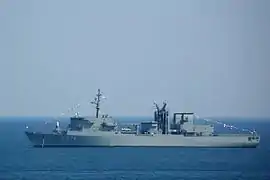 HS A-374 Prometheus at Faliron bay (2008)
HS A-374 Prometheus at Faliron bay (2008)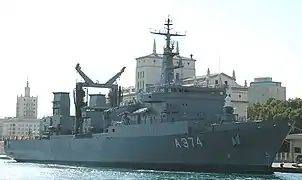 HS Prometheus A374 in the porto of Málaga (2005)
HS Prometheus A374 in the porto of Málaga (2005)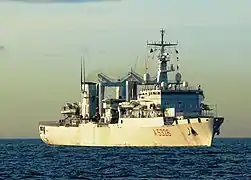 A 5326 Etna at the port of Cartagena, Spain (2011)
A 5326 Etna at the port of Cartagena, Spain (2011)
References
- "AN/SPS-10 - Radartutorial".
- Etna replenishment and logistic support ship, article in naval-technology.com
- "Marina Militare". www.marina.difesa.it. Archived from the original on 26 September 2011.
- HS A-374 Prometheus ship characteristics and history, Hellenic Navy official website
- Video of the HS Prometheus, Greek state TV ERT, 03/12/2017 (in Greek)
External links
- Etna (A 5326) Marina Militare website

